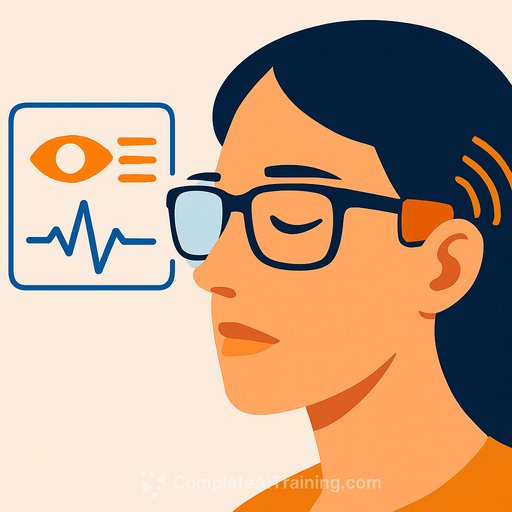AI at the eyelid: Glasses that track health through your blinks
Penn researchers have built BlinkWise, a small add-on for ordinary glasses that reads eyelid movement with radio signals and on-device AI. It captures detailed blink dynamics-duration, completeness, and timing-without using a camera and with very low energy needs. For healthcare teams, this points to practical, privacy-preserving monitoring of fatigue, mental workload, and eye surface health in daily life.
Why blinks matter in care
People blink more than 10,000 times a day. The pattern carries clinical signals: longer closures can indicate drowsiness (a major factor in crashes that cost the U.S. economy over $100 billion annually), and a rise in partial blinks is associated with dry-eye disease affecting more than 16 million Americans. Blink dynamics can also reflect cognitive load and changes in attention-useful for safety-critical work and longitudinal monitoring.
Because blink analysis is noninvasive and easy to collect, it has potential as a low-burden marker for chronic disease management and early detection of cognitive changes.
How BlinkWise works
Instead of recording images, BlinkWise sends a small radio signal and reads subtle eyelid motion. A compact model converts the signal into an "eye openness" curve in real time, resolving events at millisecond scale. This goes beyond binary open/closed detection and enables richer metrics for clinicians.
Processing stays on the glasses, reducing data movement and protecting privacy. The approach uses far less energy than streaming camera footage, and the hardware fits on a frames-mounted module.
What's different from camera-based systems
High-speed cameras in lab settings can capture blinks precisely, but they are stationary, data-heavy, and visually intrusive. Typical wearable cameras record at 30-60 fps, which can miss fast eyelid events. Radio-based sensing can sample thousands of times per second, capturing the full blink waveform while avoiding image collection.
Clinical and occupational use cases
- Transportation and shift work: continuous drowsiness and micro-sleep risk monitoring for drivers, pilots, and overnight staff.
- Ophthalmology: at-home tracking of partial blinks and closure duration for dry-eye assessment and therapy titration.
- Operating rooms and ICUs: clinician fatigue trends during extended procedures or high-acuity shifts.
- Neurology and psychiatry: objective markers of cognitive workload and attentional fluctuation in longitudinal follow-up.
- Workplace health: screen-use ergonomics and environmental dryness monitoring in office settings.
Implementation notes for healthcare teams
- Patient selection: candidates include dry-eye patients, safety-critical workers, and individuals with suspected attention or fatigue issues.
- Calibration and comfort: frames fit, nose pads, and quick per-user calibration improve signal quality and adherence.
- Data governance: radio signals are non-visual, but outputs may still be health data-treat as PHI if linked to identity; set clear retention and access rules.
- Integration: export summaries and time-series features to the EHR; consider FHIR Observation profiles for blink metrics.
- Alerting: establish context-aware thresholds to reduce false positives (e.g., drowsiness alerts during known resting periods vs. active work).
- Maintenance: define battery swap/charge routines and cleaning protocols for infection control.
- Equity and performance: validate across skin tones, eyelid anatomy, makeup, and contact lens use; monitor for model drift.
What the team built under the hood
The group redesigned the AI pipeline to run locally on a postage-stamp-sized chip with continuous signal input. By pairing low-energy radio sensing with compact models adapted from vision and signal processing, the system keeps latency low and analysis steady throughout the day.
Status and evidence
The work was presented at MobiSys 2025 (Tracking Blink Dynamics and Mental States on Glasses; DOI: 10.1145/3711875). Early results show fine-grained tracking in real-world use without cameras. Larger clinical studies will need to establish accuracy across populations, correlate blink features with gold-standard measures (e.g., PERCLOS, Schirmer testing), and define clinically meaningful thresholds.
Why this matters for healthcare
Glasses sit at the best vantage point for continuous ocular and cognitive signals. A camera-free, on-device approach reduces privacy concerns and data overhead, making continuous monitoring more feasible in clinics and at home. If validated at scale, blink dynamics could become a standard digital vital for safety, symptom tracking, and early warning.
Key takeaways
- BlinkWise captures blink dynamics with millisecond precision using radio sensing and on-device AI, avoiding cameras.
- Primary targets: drowsiness, dry eye, and mental workload monitoring in real-life settings.
- Privacy and energy efficiency make it practical for daily wear and clinical workflows.
- Next steps: clinical validation, EHR integration, and clear alerting protocols for frontline teams.
Your membership also unlocks:






